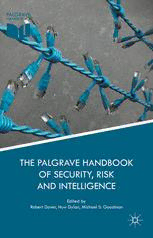Table Of ContentThe Palgrave Handbook of Security,
Risk and Intelligence
RobertDover(cid:129)HuwDylan(cid:129)MichaelS.Goodman
Editors
The Palgrave
Handbook of Security,
Risk and Intelligence
Editors
RobertDover HuwDylan
PoliticsandInternationalRelations DepartmentofWarStudies
UniversityofLeicester King’sCollegeLondon
Leicester,UnitedKingdom London,UnitedKingdom
MichaelS.Goodman
DepartmentofWarStudies
King’sCollegeLondon
London,UnitedKingdom
ISBN978-1-137-53674-7 ISBN978-1-137-53675-4(eBook)
DOI10.1057/978-1-137-53675-4
LibraryofCongressControlNumber:2017938276
©TheEditor(s)(ifapplicable)andTheAuthor(s)2017
Theauthor(s)has/haveassertedtheirright(s)tobeidentifiedastheauthor(s)ofthisworkin
accordancewiththeCopyright,DesignsandPatentsAct1988.
Thisworkissubjecttocopyright.AllrightsaresolelyandexclusivelylicensedbythePublisher,
whether the whole or part of the material is concerned, specifically the rights of translation,
reprinting, reuse of illustrations, recitation, broadcasting, reproduction on microfilms or in any
otherphysicalway,andtransmissionorinformationstorageandretrieval,electronicadaptation,
computersoftware,orbysimilarordissimilarmethodologynowknownorhereafterdeveloped.
The use of general descriptive names, registered names, trademarks, service marks, etc. in this
publicationdoesnotimply,evenintheabsenceofaspecificstatement,thatsuchnamesareexempt
fromtherelevantprotectivelawsandregulationsandthereforefreeforgeneraluse.
Thepublisher,theauthorsandtheeditorsaresafetoassumethattheadviceandinformationinthis
bookarebelievedtobetrueandaccurateatthedateofpublication.Neitherthepublishernorthe
authorsortheeditorsgiveawarranty,expressorimplied,withrespecttothematerialcontained
hereinorforanyerrorsoromissionsthatmayhavebeenmade.Thepublisherremainsneutralwith
regardtojurisdictionalclaimsinpublishedmapsandinstitutionalaffiliations.
Coverimage©adventtr/GettyImages
Printedonacid-freepaper
ThisPalgraveMacmillanimprintispublishedbySpringerNature
TheregisteredcompanyisMacmillanPublishersLtd.
The registered company address is: The Campus, 4 Crinan Street, London, N1 9XW, United
Kingdom
P : S C
REFACE TUDYING ONTEMPORARY
I S
NTELLIGENCE AND ECURITY
The Palgrave Handbook of Security, Risk and Intelligence provides a detailed
analysis of the current risks and threats present in the international system.
These threats are not filtered for a particular geographical bias; they are
analysed where they occur rather than where any political standpoint would
prefertoseethemoccur.Consequentlythisbookcuratesinternationalthreats
thatarepresentlyactive,orthatcanbeanalysedfromourcurrentvantagepoint
to take on a regional or international significance. Its underlying emphasis is
the change that has and continues to occur, its implications for security, and
the challengesmanifest in itsmanagement.
The Handbook locates its risks and threats not from a pre-formed list of
obviousissues,butfromourownhorizonscanofwherethesethreatsemanate
geographicallyandthematicallyacrosssocial,economicandpoliticalphenom-
ena.Weconsiderthesethreatstobebroadranging,fromsocialmovementsto
technologicaldevelopments,butwebelievethatintelligencewillhaveacrucial
role to play in managing the different types of risk that these developments
present. Understanding intelligence and its place in government – or indeed,
increasinglybeyondgovernment–isthereforeourpointofdeparture.Thefirst
chapterconsidersthechallengesofestablishingatheoreticalstateoftheartfor
security and intelligence. But beyond this the Handbook does not seek to
approach its task or the individual topics from any particular theoretical per-
spective: indeed, itis deliberatelyempiricist in itsapproach.
The Handbook isdivided intofour thematicsections:
(1) TheChangingNatureofConflictandCrises:thissectionconsidersa
widerangeofissuesrelatedtothedevelopmentofmodernconflicts,the
fallout from them, and the impact this generates. We consider issues
ranging from the challenges posed by the movement of people and by
the consumption of raw materials, to bio-security, the flow of capital,
across to the changing nature of armed conflict and insurgency. Many
ofthechallengesthatmakeupthissectiondovetailandareimpactedby
other challenges identified within the section and the broader
v
vi PREFACE:STUDYINGCONTEMPORARYINTELLIGENCEANDSECURITY
Handbook: taken together they underline the complexity of issues – in
public policy and security terms – that make up this area and suggest
that managing the risks they pose required a concerted, inter-agency,
andinternationaleffort.
(2) TheChangingNatureofTechnologyisnowquitewellmappedinthe
extant literature – the discussion of the real-world impacts of the
technology, what it means for the individuals affected by technology,
andbygovernmentsandprivateactorsusingthetechnologyislesswell
developed. This section of the Handbook bridges the gap between
technology publications, which explain the theoretical possibilities of
wherethetechnologysits(oftenfarinadvancetoactualusage),andthe
legal and activist literature (which seeks to apply regulatory brakes to
theactualusage).Itconsidershowtheevolvingtechnologicalenviron-
mentaffectsthe‘traditional’practiceofsecurityandriskmanagementin
the state system; for instance, how will technology influence and affect
espionage?Itengageswiththecurrentrisksandopportunitiesrelatedto
cybersecurity,andtheimplicationthishasformaintainingstatesecrets;
it also looks forward to the risks inherent in the rapid development of
artificial intelligenceandcoverttechnological attacks.
(3) The Changing Nature of Intelligence is a matter of fundamental
importance in the identification, management and mitigation of risks
to security. Chapters in this section build upon several of the views
presentedinthefirsttwosectionstodrawtogetherthebestanalysison
the evolution of intelligence as a craft, moving beyond the simplistic
memes of ‘information revolution’ and ‘surveillance society’. The sec-
tion begins with a consideration of an issue central to several of the
subjects considered in the Handbook: globalisation. A central focus is
exploring the impact this phenomenon has on intelligence, from a
broader historical perspective. The subsequent chapters build upon
thisbyexaminingvariouswaysthatintelligenceagencies,inanincreas-
ingly globalised threat environment, are adapting – either through
increasingtheircapacity-buildingprogrammes,privatisation,orbysim-
ply expanding their efforts to engage with those who pose seemingly
intractablesecuritychallenges.Althoughtechnologyandthemannerin
which threats materialise are drivers for significant change, there is
muchin theoperationalart of intelligencethatremains constant.
(4) TheChangingNatureofGovernanceintheDevelopedWorldisour
fourthsection.Atthecoreofthissectionisthequestionofachanging
social contract between governments and peoples, partly driven by the
transnationalisation of experience and also by some more traditional
economic and political shifts. Many of these issues and challenges that
ariseoutofthisquestionrevolvearoundissuesoflegitimacyandethics–
particularly with regard to extraterritorial legal systems, and the activ-
ities of intelligence agencies in the age of bulk data – and these are
extremely problematic to manage, or even to negotiate, in an
PREFACE:STUDYINGCONTEMPORARYINTELLIGENCEANDSECURITY vii
environment of increasing mistrust of authority. They are also inti-
matelylinkedtothedevelopmentshighlightedintheprevioussections,
particularly technology and its effect on the volume and availability of
information at people’s disposal. The most significant issue in this
regard may be the development of the media, and how digital media
functions asavectorof security, insecurityandintelligence.
The authors who have contributed to this Handbook share the values of the
project:eachhasconsiderableexperiencewithandconnectivitytopractitioner
communities, and they are strongly empirically grounded scholars. Taken
together the chapters represent something of the changing nature of security
and intelligence in the twenty-first century. It is a time of evolution and
revolution, and as these chapters demonstrate, as the threats and security
environment change,so toowill allelsehave to adapt.
Robert Dover,Huw Dylan,MichaelS. Goodman
C
ONTENTS
The Quest fora Theoryof Intelligence 1
Claudia HillebrandandR. Gerald Hughes
SectionI The Changing Natureof ConflictandCrises
Rapid Urbanisationand Security: Holistic ApproachtoEnhancing
Securityof UrbanSpaces 27
KseniaChmutina andLeeBosher
EnergySecurity 47
Petra Dolata
Evolving Biosecurity Frameworks 63
CaitrionaMcLeish
ResilienceandNational Security 79
Gail Ridley
Proxy Warsandthe ContemporarySecurityEnvironment 99
VladimirRautaandAndrew Mumford
ResilienceandCriticalInfrastructure: Origins, Theories,
andCritiques 117
ChrisZebrowskiandDaniel Sage
Intelligence andOrganisedCrime –ParadigmsandParadoxes 137
John F.Buckley
ix
x CONTENTS
SectionII The ChangingNature ofTechnology
CyberSecurity 157
Scott Jasperand JamesWirtz
SecuringState Secrets 177
Patrick F.Walsh
The Riseof SmartMachines: The Unique Perilof Intelligent
Software Agentsin Defenseand Intelligence 195
Nina A.Kollars
‘The More ThingsChange’: HUMINTin the CyberAge 213
David V. Gioe
Drones –Opportunities, ThreatsandChallenges 229
Peter Lee
Invisible Battlegrounds:On ForceandRevolutions, Military
andOtherwise 247
MichaelWarner
SectionIII The Changing Natureof Intelligence
Globalisation andIntelligence 265
Zakia Shiraz
CapacityBuilding andSecuritySectorReform 281
Paul Jackson
Privatisation 297
DamienVan Puyvelde
Criminality, Terrorismandthe Changing Natureof Conflict:
The Dynamicsof the NexusBetween CrimeandTerrorism 315
Angela Gendron
SecretInterventions andClandestine Diplomacy 335
Huw Dylan
Social MediaIntelligence (SOCMINT) 355
David Omand
CONTENTS xi
Corporate Intelligence 373
ArthurWeiss
SectionIV TheChangingNatureofGovernanceintheDevelopedWorld
The Ethicsof Intelligence 395
RossBellaby
Risk,SecurityandInternational Law 411
Robert Dover
The Changing Media 429
Peter Busch
Terrorismand theNews Media: Symbiosis, ControlandFraming 443
AlexanderSpencer
TwoWorlds,OneCommonPursuit:WhyGreaterEngagementwith
theAcademicCommunityCouldBenefittheUK’sNationalSecurity 461
Robert Dover,MichaelS.Goodman andMarthaWhite
The Ethicsof Whistleblowing,Leaking andDisclosure 479
Seumas Miller
Index 495

